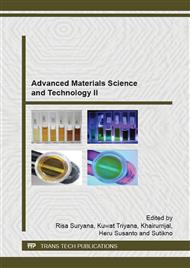p.92
p.96
p.100
p.104
p.109
p.114
p.119
p.123
p.127
The Effect of Milling Time and Sintering Temperature on Synthesis of PbTiO3 by Mechanical Alloying
Abstract:
PbTiO3 is one of electroceramic materials which can be applied for electronics and microelectronics due to their dielectric, pyroelectric, and piezoelectric properties. The members of PbTiO3-based ferroelectrics are widely used in multilayer, actuator and sensor capacitor. At room temperature, PbTiO3 has a tetragonal perovskite structure. In this research, PbTiO3 particles are synthesized by mechanical alloying method with variation of milling time and sintering temperature. The milling time variation is taken for 10, 20 and 30 hours. Sintering temperature variation is performed at 850, 900 and 1000°C. The powders used in the milling process are PbO and TiO2 powders. X-Ray Diffraction (XRD) and Scanning Electron Microscopy–Electron Difraction X-ray (SEM-EDX) are performed to analyze the formation of PbTiO3 phase. It is found that the synthesized powders contain 100% PbTiO3 phase for all sintering temperatures. The PbTiO3 particles have agglomeration shape with a broad particle size. The electrical properties of PbTiO3 are measured using electrical test device. Electricity test analysis shows that the synthesized PbTiO3 behaves as semiconductor-like.
Info:
Periodical:
Pages:
109-113
Citation:
Online since:
August 2015
Authors:
Keywords:
Price:
Сopyright:
© 2015 Trans Tech Publications Ltd. All Rights Reserved
Share:
Citation:


